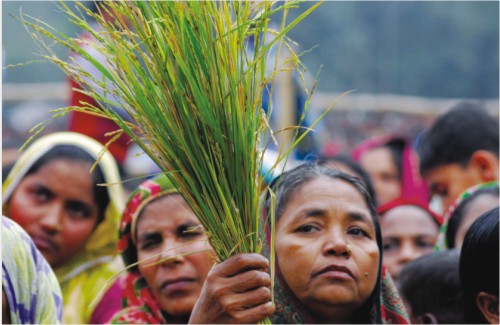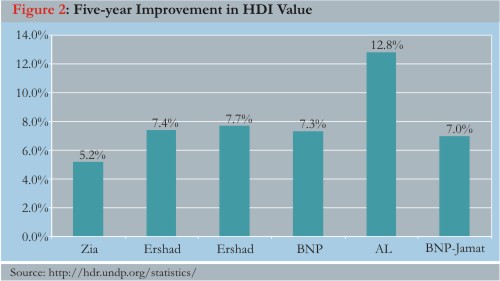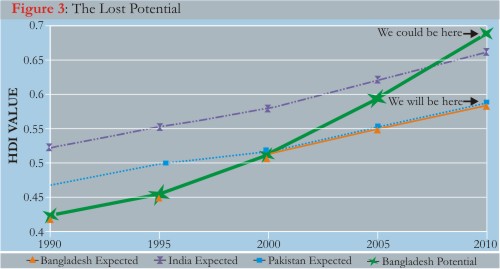
Inside
|
The Lost Decade Zakaria S. Khondker
In 2006, the then prime minister, borrowing words from her alliance partner Motiur Rahman Nizami, who once claimed: "There is no Bangla Bhai, he is the media's creation" proclaimed: "I can prove with statistics, there has been no price hike in my tenure, it is the media's creation." After her release from jail, she also claimed that her tenure was a "golden age." The truth could not be further from what she claimed. She either failed to realise the truth about her misrule or was deliberately lying. It is high time that responsible citizens dig out the truth and debunk such lies, especially since they came from a former prime minister. Lost GDP marathon: Figure 1 shows the GDP growth rates of three major players in South Asia as reported by the Asian Development Bank. During Mrs. Zia's tenure between 1991-1995, Bangladesh, with an average of 4.4% annual GDP growth, was behind the other two players in the region -- India with 5.2% and Pakistan with 4.9%. That changed in 1996-2001. With Hasina in power, Bangladesh achieved 5.2% growth, and although it was still behind India it was 1.2% above Pakistan's 4% annual growth. With Mrs. Zia back in power in 2001, Bangladesh faced a setback in growth. Although it still had a GDP growth of 5.5%, a little above the previous five years, it lost its edge over Pakistan and fell further behind India. Growth is a race of nations, you can run faster and still fall behind others. If Bangladesh could achieve the same hike in growth as Pakistan, its GDP growth would have been 6.5% instead of 5.5%, a gain of 1%; a similar comparison could be made with India as well. The difference with India and Pakistan was even more dramatic in 2006, the final year of BNP-Jamaat's tenure. We should have had 8.2% growth if compared to India and 7.7% if compared to Pakistan, instead we had only 6.5%.
This loss of more than 1% growth may have been caused by Mrs. Zia's sons and cronies, as well as her mismanagement of the power sector and lack of action. The growth loss for six years accumulates to more than 6%, in other words one year of GDP growth was gobbled up by BNP-led government. Dark Age of human development: There is more to the story. GDP growth alone fails to reflect the lives of millions as a few filthy rich getting richer can skew the GDP when the lives of millions still get worse. GDP also fails to predict the future, whether a country can keep up in the marathon of growth, and what it can achieve in the near and distant future. Keeping that in mind, UNDP records the Human Development Index (HDI), combining GDP growth with education and health indicators together. They publish trends in human development for the countries since 1975, which can be analysed to find where a country has been and where it is heading. If a country's average citizens have achieved more education and healthier lives, the fruits of development have reached the masses, not just a few filthy rich; it also indicates that today's achievement in education and healthy life will contribute to tomorrow's productivity and economic growth. If we have strong economic growth today but fall behind in maintaining healthy lives or better education it will haunt economic growth tomorrow. The HDI value is a far better measure of a nation's progress than GDP.
The pillars in Figure 2 are five-year rates of human development in Bangladesh. The periods can be broadly categorised by different tenures: 1976-80 Zia, 1981-90 Ershad, 1991-95 BNP, 1996-2000 AL, 2001-2005 BNP-Jamaat. As you can see, the growth rate was at the lowest at 5.2% during General Zia's tenure and improved during General Ershad's tenure to 7.4% and 7.7%, respectively. Mrs. Zia's performance in her first tenure was better than her husband's, but still worse than military dictator Ershad's two tenures. Then in 1996-2000, during Hasina's rule, human development jumped up a spectacular 74% to reach 12.8%. Despite its failure to control the goons within the party, Awami League had achieved unprecedented success in development. Catastrophe hit hard in 2001, when BNP and its partner Jamaat took power. Human development growth for Bangladesh nose-dived to 7% for five-years, down by 45% from what Awami League had achieved. BNP-Jamaat emerged as the rulers of the Dark Age. They turned a spectacular growth rate into the worst in 30 years.
This compares to a development train wreck; one driver was running the development train at 128 km/hour but the next driver slowed it down to 70 km/hour. The statistics indeed do suggest that Sheikh Hasina's tenure was a Golden Age of modern Bangladesh. Awami League posted 12.8% growth and BNP-Jamaat only 7.0%, a difference of 5.8%. Why does the loss in GDP growth not look as bleak as lost human development? While khamba (electric pillar) business may benefit the prince and add to GDP growth, it adds nothing to improve the lives of ordinary people. While syndicated price hike and extortion benefits the cronies of BNP and partly adds to GDP, it takes away from ordinary people. That is why it would not add much to human development. Add up the lost wealth of masses caused by syndicated inflation that eats into wealth like termites and you will see why they pocketed one year's worth of GDP growth but three and half year's worth of human development. The lost potential: What could happen if Hasina's development was matched for the next ten years? From the final five years of the last century to the first five years of this century Bangladesh lost 45% of the growth in human development, while India gained 45% and Pakistan gained 77%. Could Bangladesh match India's gain of 45% to reach a five-year development of 19% or Pakistan's 77% gain to reach 23%? That was our potential, we have lost it to looting, mismanagement, and inaction.
Had the relative development remained at par with India's 45% gain instead of a 45% loss we could have caught them by 2005. Even if we had a 25% improvement over the previous five years today and continued for five more years (far below India's 45% and Pakistan's 77%) we could have passed Pakistan back in 2002 and overtaken India by today (shown in Figure 3). Instead, today, we are where Pakistan is and where India was back in 2000. At today's rate we will never catch India. Even if we get back to Hasina's record, with a whopping 80% improvement over BNP-Jamaat, it will take more than another decade to catch India. This is our lost decade. Myths of development: For as long as the records are available General Zia had the worst performance in our human development history (Figure 2). The slogan "Zia, the nation builder" is an urban legend, the truth lies at the other end. If you factor in the fact that the country was emerging from the ravages of the war and colonial era repressions you can forgive Zia. In that case his wife holds the title. It is beyond my comprehension on what basis Mrs. Zia claims that her tenure was a "Golden Age." There were only two tenures in record when development actually slowed down instead of picking up -- both were hers. As far as I see she only ruled the in the Dark Ages. Bangladesh never faced such a national disaster for such a long period, never has the drop in development been so dramatic. Historical perspective: After winning the Battle of Plassey, Robert Clive collected £2.5 million for the East India Company, and £234,000 for himself from the Nawab's treasury, when an average British nobleman could live a decent life with an annual income of £800 only. The East India Company plundered the Bengal treasury and the money flowed out of the country. The company increased land taxes from 10% to 50% of the value of the agricultural product and monopolised grain trading. The result of all this looting was the infamous Bengal Famine that wiped out a third of the population. After Mrs. Zia's victory in 2001, her sons and cronies collected massive wealth through
extortion and bribes, monopolies in businesses like electric pillars, and syndicated price-hike; tactics similar to the East India Company's. Those 200 suitcases in a trip to Saudi Arabia in 2006, confiscation of wealth by the Malaysian government few years back, or confiscation of Tk.11 crore by the Singapore government are just the tip of the iceberg. Just like the Bengal Famine caused by the East India Company, hunger forced many like Dipali and Manjuara to commit suicide. A freedom fighter killed himself because of hunger following a few years of BNP-Jamaat rule. Centuries of colonial rule changed Golden Bengal into a nation of poverty and famine. During the five-years of BNP-Jamaat rule, the "Crown Prince" and company emerged as the East India Company of the 21st century, who gobbled up more than a year of GDP growth and three and half years of human development. Just like the East India Company, which diverted massive wealth to England, Mrs. Zia's sons and cronies diverted massive wealth overseas to countries like Saudi Arabia, South Africa, Switzerland, Malaysia, and Singapore to name a few. A decade lost: The impact of the colossal loss will be felt for years. It will take several years to improve the power sector and build infrastructure. The relative loss in education and health will affect productivity for years to come, when our neighbors could go beyond reach. Until 2010, there will not be much visible change. Emerging from colonial era repression, most of the former colonies took decades to repair the damages, build infrastructures, and educate the people to start the growth engine. After the colossal loss we faced for more than half of the decade, it will take another half to make up for the damage. This is especially true when the world is facing a severe downturn. For millions of Bangladeshis, the first decade of the 21st century will be the lost decade inflicted by the colonial-style looting and resource diversion by natives, Mrs. Zia's sons and cronies. Zakaria S. Khondker is a PhD student of Biostatistics, Gillings School of Global Public Health, University of North Carolina at Chapel Hill, US. |





